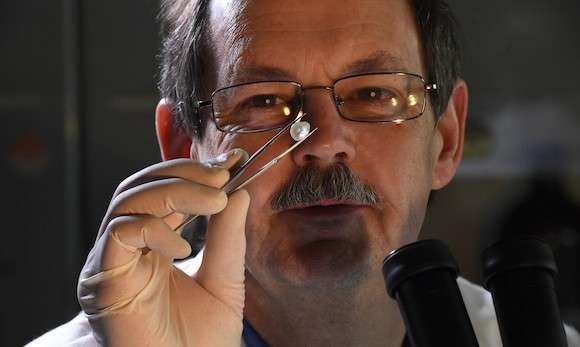Eight-carat diamond smashed in the name of science

At the University of Melbourne, a rare, eight-carat diamond has been smashed to smithereens in a bid to discover the secrets of its origin and a potential 'mother lode' of diamonds.
Professor David Phillips, Head of the School of Earth Sciences at the University of Melbourne, recently took a hammer to the diamond to extract two rare, emerald-coloured inclusions.
The inclusions are made of a green mineral called clinopyroxene, which contains small amounts of radioactive potassium.
This makes it possible to date when the diamonds erupted out of a volcano, after they were formed inside. Knowing this makes it easier to hunt down the original source and the all-important 'mother lode' of diamonds.
"It's like looking for a unique word in 'War and Peace' and instead of having to search the whole book, you only have to look through a handful of pages," Professor Phillips says.
This pea-sized diamond was worth $7000 uncut and was found in a South African riverbed by exploration company Namakwa Diamonds.
It's one of many North West Province diamonds whose source is widely debated, but as yet unknown.
Namakwa Diamonds donated the gem – plus a smaller 0.75-carat diamond – to Professor Phillips hoping he could provide some clues.
Recently, Professor Phillips and a University of Melbourne team successfully dated clinopyroxene inclusions in diamonds from the Namibian coast, tracing them to volcanoes more than 700km away.
Professor Phillips has performed many clinopyroxene inclusion extractions, but usually for gems much smaller in size.
He had never broken a diamond of this size before and admitted that the chance of inclusion recovery was "about 50/50".
"Large stones are far more challenging," Professor Phillips says.
"There is a risk of pulverising the clinopyroxene inclusions and ruining the experiment – and the diamond."
But the 'delicate' process of hammering the diamonds into pieces was a success.
Professor Phillips has since sent the inclusions to be irradiated at the Oregon State University nuclear reactor, which will then return the inclusions to the University of Melbourne to be dated in the Earth Science's state-of-the-art spectrometer.
Results are expected early next year.
Provided by University of Melbourne



















